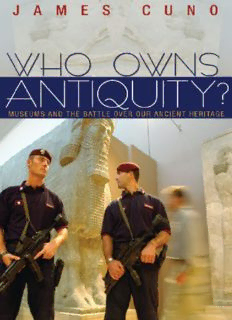
Who Owns Antiquity?: Museums and the Battle over Our Ancient Heritage PDF
Preview Who Owns Antiquity?: Museums and the Battle over Our Ancient Heritage
WHO OWNS ANTIQUITY? 0011__CCuunnoo__PPrreelliimmss__pp0000ii--ppxxll..iinndddd ii 22//2299//22000088 1111::2255::1188 AAMM 0011__CCuunnoo__PPrreelliimmss__pp0000ii--ppxxll..iinndddd iiii 22//2299//22000088 1111::2255::1188 AAMM J A M E S C U N O WHO OWNS ANTIQUIT Y? MUSEUMS AND THE BATTLE OVER OUR ANCIENT HERITAGE PRINCETON UNIVERSITY PRESS • PRINCETON AND OXFORD 0011__CCuunnoo__PPrreelliimmss__pp0000ii--ppxxll..iinndddd iiiiii 22//2299//22000088 1111::2255::1199 AAMM Copyright © 2008 by Princeton University Press Published by Princeton University Press, 41 William Street, Princeton, New Jersey 08540 In the United Kingdom: Princeton University Press, 6 Oxford Street, Woodstock, Oxfordshire OX20 1TW All Rights Reserved ISBN-13: 978-0-691-13712-4 Library of Congress Control Number: 2008922048 British Library Cataloging-in-Publication Data is available This book has been composed in Minion with display font in Bernhard Fashion Printed on acid-free paper ∞ press.princeton.edu Printed in the United States of America 1 3 5 7 9 10 8 6 4 2 0011__CCuunnoo__PPrreelliimmss__pp0000ii--ppxxll..iinndddd iivv 22//2299//22000088 1111::2255::1199 AAMM For Sarah, Claire, and Kate * 0011__CCuunnoo__PPrreelliimmss__pp0000ii--ppxxll..iinndddd vv 22//2299//22000088 1111::2255::1199 AAMM Nationalism becomes self-reproducing in a world of nation-states. For once the world has defi ned “normality” as national solidarity and national statehood, every nation must be vigilant against signs of cultural assimilation and must produce nationalists whose self-appointed task is to strengthen national identity and uniqueness in order to increase social cohesion and solidarity. In a world of nation-states, nationalism can never be ultimately satisfi ed. —Anthony D. S. Smith, Nationalism in the Twentieth Century (1979) * Economic integration, and with it cultural globalization, has far outpaced our global mindset, which is still rooted in nationalist terms. We benefi t from all that the world has to offer, but we think only in narrow terms of protecting the land and people within our national borders—the borders that have been established only in the modern era. The barbed wire, chain-link fences, security forces, and immigration and customs agents that separate us from the rest of the world . . . cannot change the fact that we are bound together through the invisible fi lament of history. — Nayan Chanda, Bound Together: How Traders, Preachers, Adventurers, and Warriors Shaped Globalization (2007) 0011__CCuunnoo__PPrreelliimmss__pp0000ii--ppxxll..iinndddd vvii 22//2299//22000088 1111::2255::1199 AAMM CONTENTS * Preface ix Introduction: The Crux of the Matter 1 ONE Political Matters 21 TWO More Political Matters 44 THREE The Turkish Question 67 FOUR The Chinese Question 88 FIVE Identity Matters 121 Epilogue 146 Notes 163 Select Bibliography 207 Index 217 0011__CCuunnoo__PPrreelliimmss__pp0000ii--ppxxll..iinndddd vviiii 22//2299//22000088 1111::2255::1199 AAMM 0011__CCuunnoo__PPrreelliimmss__pp0000ii--ppxxll..iinndddd vviiiiii 22//2299//22000088 1111::2255::1199 AAMM PREFACE * It is the magic of nationalism to turn chance into destiny. — Benedict Anderson1 I. Through the fi rst decade of the nineteenth century, Thomas Bruce, 7th Earl of Elgin, British ambassador to the Ottoman court in Con- stantinople from 1799 to 1803, had numerous sculptures removed from the Parthenon in Athens and shipped to London. He did so, we are told, with permission from the governing Ottoman authorities. The original legal instrument has disappeared and is said to exist only in an Italian translation made for Elgin by the Ottoman court. Some then and now question the legality of Elgin’s actions. The Italian lan- guage document gives Elgin the right to draw, measure, and make plaster casts of the sculptures, and dig for others that might have been buried. It also allows for “some pieces of stone with old inscriptions and fi gures” to be taken away. Did this refer to the sculptures on the building or only the fragments found on the ground? The document is not clear. And without greater clarity (and, at this point, probably even with it), no legal case can be made against Britain’s ownership of the marbles. Still, the modern government of Greece has consistently called for their return. Whatever the legal circumstances of Elgin’s actions, they could hardly have been surreptitious. The sculptures, both freestanding and in relief, were numerous and heavy and had to be taken off the build- ing and down from the temple’s considerable height. They then had to be transported to ships, where, for fear of sinking the ships them- selves, Elgin’s agents sawed off the backs of the thickest relief slabs 0011__CCuunnoo__PPrreelliimmss__pp0000ii--ppxxll..iinndddd iixx 22//2299//22000088 1111::2255::1199 AAMM
Description: